How ‘Shōgun’ Found Its Way – Behind The Scenes On FX’s Hit With Hiroyuki Sanada, Anna Sawai, And Tadanobu Asano

It’s a late April afternoon when Shōgun breakout star Anna Sawai, who stars as the fierce Lady Toda Mariko in the gorgeously wrought, sharply modernized adaptation of James Clavell’s 1975 bestseller, spots castmate Tadanobu Asano and producer-star Hiroyuki Sanada across a studio floor. Her face lights up. It hasn’t even been a week since FX’s runaway hit historical drama ended its debut season on a breathtaking note of bittersweet catharsis, having enthralled viewers over 10 episodes with its sweeping saga of survival and sacrifice in 17th Century Japan. But as the rising actress reunites with her Shōgun co-stars, a new charge of electricity crackles in the air.
Mariko-sama, Lord Yoshii Toranaga, and the impish schemer Kashigi Yabushige, together again in another life. (Well, Los Angeles.) The trio has traveled from far-flung cities to mark a groundbreaking moment in which Shōgun is setting sail for a new destination: the Emmys.
More from Deadline
It was not long ago that Sawai, at a turning point in her own burgeoning career, asked the question on everyone’s mind in her first meeting with Shōgun creators Justin Marks and Rachel Kondo: “Why do you want to remake this?” Clavell’s novel, based on feudal Japanese history, sold 7 million copies decades prior and had been, either famously or infamously, adapted into a 1980 miniseries starring Richard Chamberlain and Toshiro Mifune, spinoff video games, and even a stage musical, inspiring countless Hollywood derivatives that centered white saviors at the expense of Asian characters. But Marks and Kondo had a different approach in mind. With unprecedented diligence to historical and cultural authenticity and a wildly ambitious scope, their five-year journey shepherding Shōgun involved pandemic delays, extensive research, a massive 10-month shoot, and more than 3,000 international cast and crew creating new methods to tell their story in a uniquely cross-cultural way.
The most expensive production in FX history, the investment paid off with 9 million viewers in six days across Hulu, Disney+, and Star+, and drew praise stateside and in Japan, with admirers including Hideo Kojima comparing it to Game of Thrones. It even beat The Bear Season 2 and The Kardashians in domestic and international viewership, respectively, to score a No. 1 global debut; insert smiling Fuji (Moeka Hoshi) gif here.
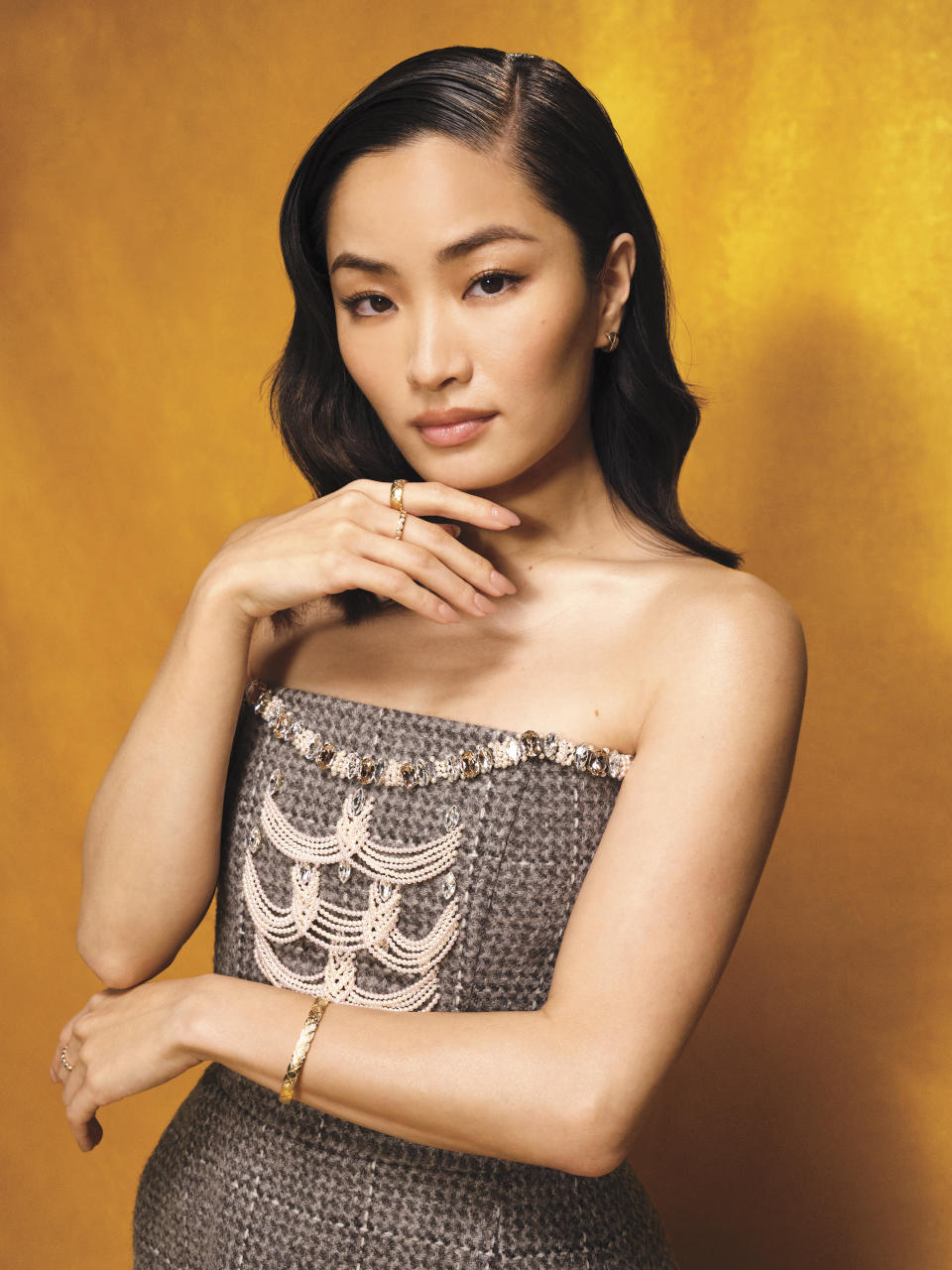
A few months from this debut, in May, FX and Hulu will send Shōgun fans and awards watchers into a tizzy with news that the acclaimed historical drama will be renewed for two more seasons, switching the Emmys frontrunner from Limited Series to Drama contention. Yes, in spite of the fact that its intertwined narratives of Sanada’s embattled bushō Toranaga, marooned English navigator John Blackthorne (Cosmo Jarvis), and Christian noblewoman interpreter Lady Mariko had already played out Clavell’s near 1,200-page novel to its conclusion.
On this spring day with the finale fresh in mind, however, the success of the show, evidenced by critical acclaim, viral memes, and ratings wins, is still sinking in for these three generations of Japanese talent. The veteran elder statesman, the art house darling, and the newcomer; none had yet seen, let alone been invited to participate in, a project like this for Asian actors in Hollywood, the first Western production of its scale to center on Japanese characters with a predominantly Japanese cast, in a story told largely in the Japanese language.
Shōgun had proved so popular that, in recent weeks, Sanada and Sawai embarked on a whirlwind U.S. promotional tour, hitting the likes of Good Morning America, Jimmy Kimmel and Kelly Clarkson on the talk show circuit. Sawai even taught Stephen Colbert how to walk Mariko-style, feet pointed inward in the disciplined gait of a 17th Century Japanese noblewoman, across the Ed Sullivan Theater stage.
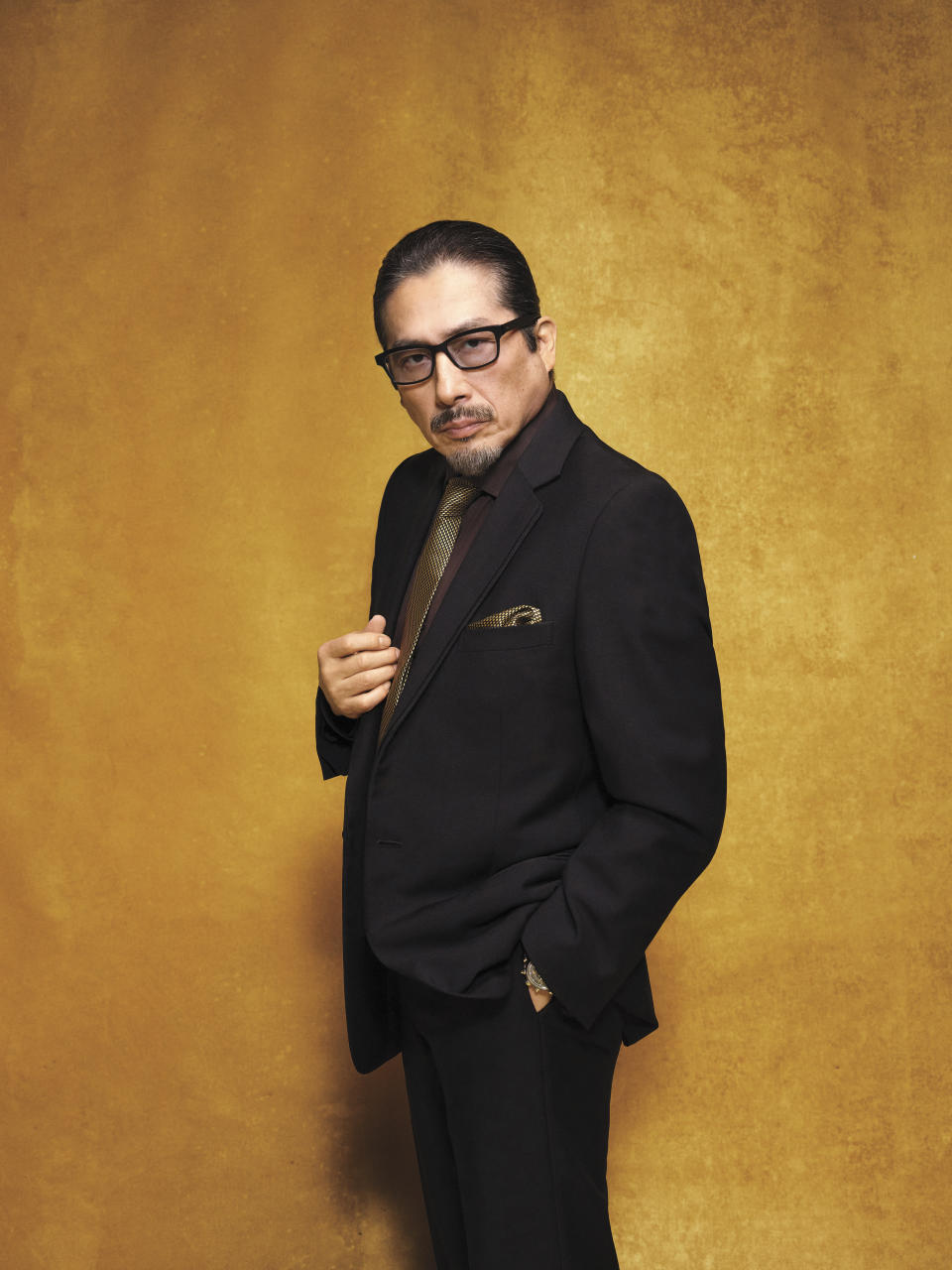
48 hours earlier, Sanada — who took on a career-first producer credit while also starring as Toranaga, based on the real Tokugawa Ieyasu who was known as one of the ‘Great Unifiers’ of Japan — attended the glitzy White House Correspondents’ Dinner in Washington, D.C. where he was humbled as other guests approached him to gush over the show. “It was a great reaction. More than we expected when we made it,” he says happily.
Now he and Asano, himself a celebrated star of Japanese cinema, flank Sawai in the studio, their paces matched in dancerly synchronicity, and she jokes that this is her Beyoncé moment. No one is surprised when Sanada takes the lead and counts the trio off as they stride toward Deadline’s photographer: “One, two, three!” Days later, there’s an emotional hitch in his voice as he reflects on the fact that Shōgun has been received so warmly after the decades-long fight for Asian inclusion in Hollywood. “I could never have imagined this kind of thing happening.”
Shōgun had been in development for years by the time co-creators and executive producers Marks, an Oscar nominated screenwriter of Top Gun: Maverick, and Kondo, an award-nominated fiction writer, who are married, took over the helm. First announced in 2013 by Fox as a prestige miniseries for its then-subsidiary FX, it endured developmental stops and starts with various producers and writers attached as the company under CEO John Landgraf searched for the right way in.
Following the cancellation of his Starz series Counterpart, Marks had just signed an overall deal with FX when exec Gina Balian sent over a copy of Clavell’s novel in 2019. “The idea was: see if it speaks to you and we’ll go from there,” he says, joining Kondo over video chat from the home on Maui they share with their two children and a colorful menagerie of pets. And for ages, there on the coffee table Shōgun sat, very much unread.

“While I didn’t know the book, I did know the silhouette of the book and a lot of the movies, television shows, and stories it inspired over the years,” Marks says. The long shadow of Clavell’s internationally bestselling novel is so vast, some credit it with helping to spark the sushi boom in America in the ’80s. The 1980 miniseries’ centering of Blackthorne’s perspective, unfortunately, lent that legacy an outdated sheen to more modern sensibilities, Marks included: “I felt, in the most dickish way possible, that I knew what this was, and what story it was trying to tell.”
Then, one weekend he and Kondo began reading it simultaneously and found themselves hooked, engrossed by the book’s multiple points of view.
Fictionalizing real figures and events from a pivotal time in the waning days of Japan’s tumultuous Sengoku period, Clavell, a former British artillery officer turned screenwriter and novelist who spent years in a Japanese prisoner-of-war camp during WWII, spun a tapestry of power struggles big and small amongst characters forging their destinies in an era known as the ‘Warring States period’.
There’s the feared Toranaga, whose political rivals plot against him on the Council of Regents, formed to govern until the late Taikō’s heir comes of age; the many warlords, vassals, and opportunists whose self-serving agendas threaten a precarious peace; the Portuguese traders and Jesuit priests conniving to strengthen their foothold in Japan as religious wars rage on in Europe.
And, the two other lead protagonists of Shōgun: Mariko, the loyal survivor of a disgraced lineage who has found salvation in the Catholic faith but is still searching for her purpose; and bewildered sea pilot Blackthorne, the fish out of water ‘Anjin’ who shipwrecks on Toranaga’s shores with a Dutch vessel and is quick to judge the Japanese way of life before undergoing his own paradigm-shifting journey of understanding.
Throw in sea storms, bandit attacks, daring escapes, secret alliances, courtly machinations, and one massively destructive earthquake, and the specter of death, colliding with themes of duty and survival, looms overhead for the characters at every turn. (Not to mention a forbidden romance, but more on that later.)
“You start reading and all of a sudden you’re a couple hundred pages in and you think, oh my god, a thousand more pages: yes,” says Kondo. “It was propulsive and highly consumable. But we both came to it a little bit cocky. I thought, obviously I’m of Japanese heritage. Between the two of us, I’m the one to speak to this subject matter. But we came to find out very quickly that couldn’t be more untrue.”
Kondo, who grew up in Hawaii, realized she too was an outsider to the feudal Japanese society backgrounding the story, instead bringing her love of period dramas to the epic, and a personal investment in its female characters. Texas-born Marks came to its action-packed narrative of political intrigue, life or death stakes, and dazzling set pieces from a genre background. Their pitch to FX executives was straightforward, embracing Clavell’s story with one vital exception.
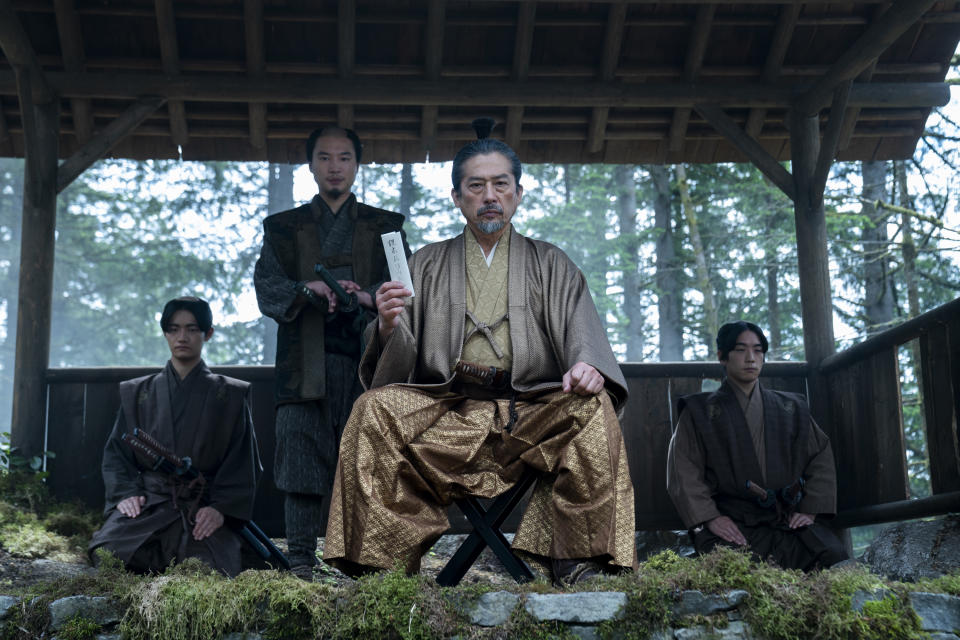
“We didn’t feel that we could successfully invert the gaze of this show because we’re not Japanese; it would be fallacy, maybe bordering on appropriation, to try to do something like that no matter how many [Japanese] people you hire,” says Marks. “What we could do would be to subvert the gaze — to take the expectations that we all have for stories like this and use them against the audience. To use Blackthorne in a way where he draws a lot of attention early on, and it allows for us to set the table for what is then a more surprising story.”
FX was onboard, and the co-creators assembled a six-month-long writers’ room of predominantly Asian American women, scripting the first two episodes themselves with Marks as showrunner. “Everyone had a specific angle on the approach that felt like it was flying in the face of what you thought this show would be,” Marks says. “Creating a conversation is the most important part of a writers’ room at the end of the day, and we felt it was important, given our audience, to wrap that conversation around the Asian American point of view and to bring that intersectional discourse into the process.”
More than Game of Thrones, the HBO fantasy megahit to which Shōgun has drawn much comparison, the writers’ room had another model in mind that they were all watching at the time: Succession. Between the dizzying power plays, backstabbing political games, and fraught relationships moving the story toward its tense denouement, the show is chock full of gory seppuku, beheadings, shinobi assassinations, cannon dismemberments, and the most loaded hand touch since Mr. Darcy helped Elizabeth Bennett out of her carriage.
It was a production of daunting scale, exacerbated by unexpected Covid filming delays and slowdowns. It had been a big win when FX agreed to make Shōgun primarily in the Japanese language, casting actors some of whom had never acted outside of Japan. But the sudden extra timing led to the creative process that would refine the writing on the show and define their overall approach.
“So much of this process has been building the car as we’re learning how to drive it,” says Kondo. “No, we didn’t know how to do any of this. And it was, let’s say, controlled chaos for a very long time.” Case in point: Translating the show’s dialogue, originally written in English, into spoken Japanese performed by the cast.
Working with consulting producer Mako Kamitsuna and researcher Frederik Cryns, each script was pored over and fine-tuned for cultural nuance before being sent to a team of translators in Tokyo.
According to Kondo, the resulting language felt too modern to their Japanese producer Eriko Miyagawa and Sanada. So, the translated scripts were then sent to Japanese playwright Kyôko Moriwaki, a specialist in jidaigeki period dramas, to be further translated into historically accurate period Japanese.
Then came an unexpected serendipity as to how each word choice and mark of punctuation was then re-translated back into English subtitles. It was on set when Marks realized their linguistic telephone game could yield poetic treasures when he heard Sawai and script supervisor Kazuko Shingyoku marveling over a line in the second episode that Mariko says in Japanese to Toranaga, explaining whether her Christian faith would conflict with her service to him.

“In our version she said, ‘If I were just Christian, it would. But I’m more than one thing.’ And after all those years of going through translation after translation, it comes back to us years later as, ‘If I were just Christian, it would. But I have more than one heart,’” says Kondo. “And that’s what we ended up going with. It speaks to how this production was a collaboration at such an exquisite level. Everybody threw in everything they had, and somehow this alchemy happened.”
They applied that early lightbulb moment elsewhere, encouraging adjustments with input from their experts and craftspeople across departments. “What I can say with certainty is that I don’t believe the writer is the author of a show,” says Marks. “I believe that the process is the author of a show. And the nice thing about TV is that the writer gets to author that process.”
He even found wisdom in the very story they were telling. “You read the book and you see the way Toranaga operates and it’s like: are you a Blackthorne here, or are you a Toranaga? Are you riding straight into the wind because you think that’s heroism, or is it Toranaga, who likes to study the wind and adjust his sails, and allow that to take over the process? On this show, the success story was in the latter; in allowing for the wind to just go.”
Filming, originally slated to take place in the U.K. and Japan, eventually shifted to Vancouver, British Columbia in the fall of 2021 with a sprawling crew, including producers, consultants, and artisans flown in from Japan. (Michaela Clavell, the author’s daughter, is also an executive producer alongside Michael De Luca, Edward L. McDonnell, Kondo and Marks.)
As they’d done with their writers, they tapped directors from diverse backgrounds, including Takeshi Fukunaga, whose indie drama Ainu Mosir they’d caught on Netflix, and Hiromi Kamata, who’d go on to direct Sawai in episodes of Apple’s Godzilla series Monarch: Legacy of Monsters.
Meanwhile, department heads overseeing costumes, production design, hair and makeup, practical set builds, stunts and more dove into extensive research to create thousands of puzzle pieces needed to craft the world of Shōgun, while visual effects artists would create more than 5,000 VFX shots to bring its vast cityscapes, harrowing set pieces, and tens of thousands of battlefield soldiers to photorealistic life.
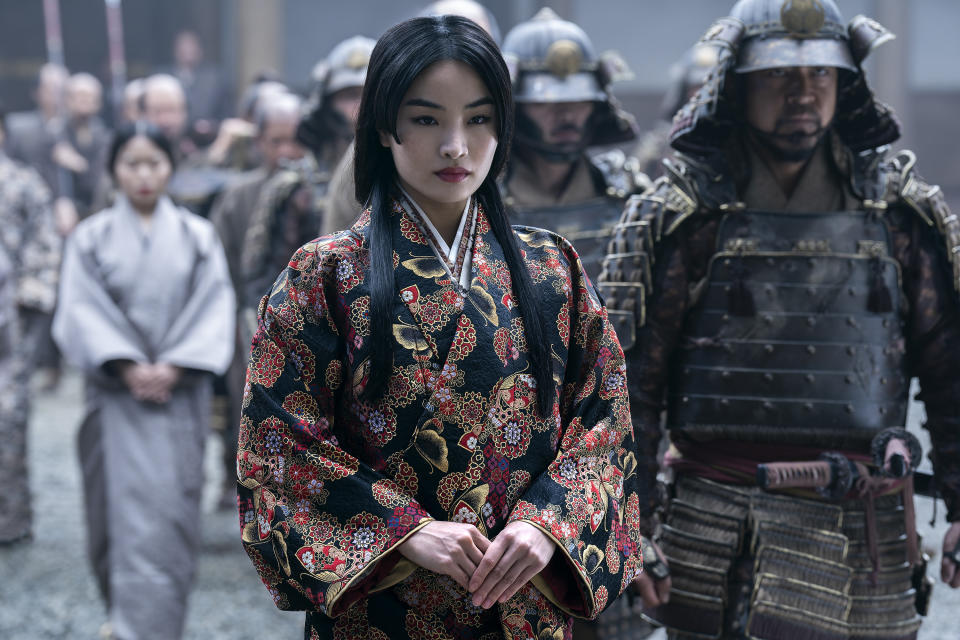
Says Marks: “The question that we all asked a lot was: how can a group of American, Canadian, and international filmmakers — European, Japanese, everyone — come together to do something that feels like it has some measure of authenticity, in spite of the fact that the authorship is diffused across culture?” Approaching it with sensitivity and respect had to be baked into the DNA of their take on Shōgun. And they already had an untapped resource at the ready.
At 63, Hiroyuki Sanada has performed King Lear with the Royal Shakespeare Company, appeared in Hollywood blockbusters like the recent Bullet Train and John Wick: Chapter 4, won the Japanese equivalent of the Oscars — twice — and received his country’s Medal of Honor for his contributions to art over his 58-year career. Among the most recognizable and celebrated Japanese actors working in Hollywood today, he had been attached to star in Shōgun even before Marks and Kondo, since its earlier iteration at FX.
No stranger to Japanese jidaigeki dramas, Sanada had even played both the real-life daimyo that inspired Shōgun’s fictional Toranaga (Tokugawa Ieyasu, in 1989’s Oda Nobunaga) and the inspiration for foe, Ishido Kazunari (Ishida Mitsunari, in the 1998 Japanese TV special Tokugawa Ieyasu and 1996 series Hideyoshi). Long before that, Tokugawa was a heroic figure in Sanada’s childhood for his legacy of creating an era of peace that lasted 260 years.
“When I thought about why I would play this role now, I thought that because human beings will never change and there’s still war all over the world, we need that kind of hero,” he says.
His Toranaga closely guards his plans with the spies of his enemies everywhere, and as Shōgun opens, the fellow Regents with whom he tenuously shares power have him imprisoned in Osaka Castle, plotting to take him out. Sanada plays him as a brilliant strategist seeing his long game to its heartbreaking conclusion, but also brings humanity and humor to the military commander, who cares deeply for his people and his dream of hard-won peace, even as he manipulates those around him like pawns.
“I didn’t want to play a stereotypical samurai character,” says Sanada, who has a gentle air of gravity about him, onscreen and off. “He’s a great leader and strategist. He has power, but he’s also a family man. He has weakness and loneliness. I wanted to make this role a more human samurai, not a ‘Shōgun’ shōgun.”
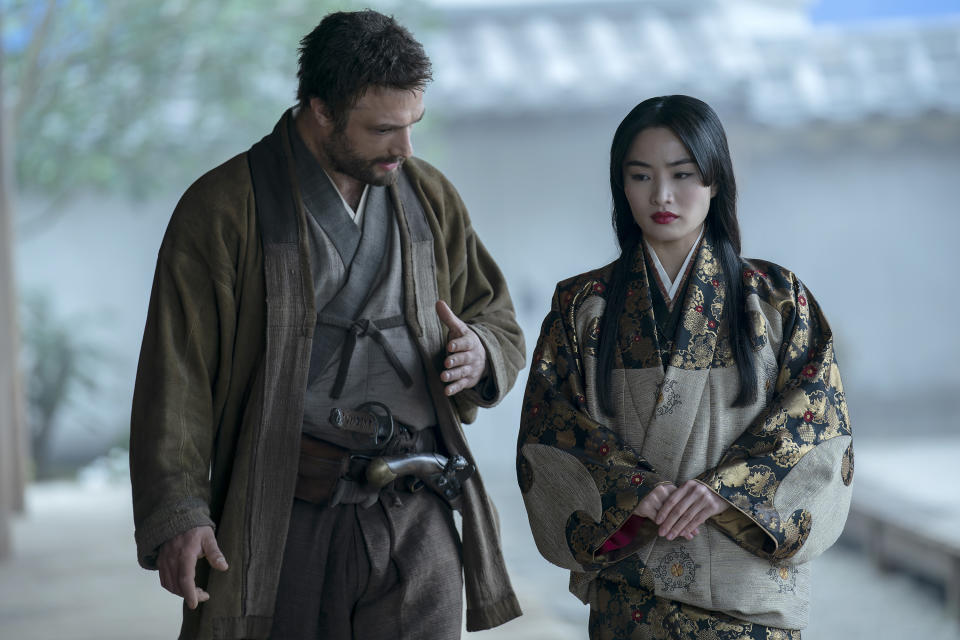
But it wasn’t until Kondo and Marks came aboard that Sanada was asked to become a producer on the show, a career-first he proudly took on all the way to the set. Born in Tokyo, Sanada moved to Los Angeles in 2005 after starring in the international hit The Last Samurai opposite Tom Cruise, to build an international career for himself at a time when Hollywood offered far fewer opportunities for Asian actors.
Along the way, he says, he found himself frustrated by the stereotypes and cultural missteps he saw on past projects. “As an actor I felt limited in saying something to correct our culture. I didn’t want to break somebody’s pride,” he says. “I spent 20 years like that. This time they asked me to become a producer and I thought, this is a good chance to tell our story to the world more authentically.”
The 10-month shoot, production designed by Helen Jarvis, took over two sprawling backlots and two soundstages. Among the sets: Osaka Castle, with its imposing stone structures and grand hall, and the fishing village Ajiro, constructed in immersive detail with samurai houses and pathways where a cedar factory once stood, outside of Vancouver.
Sanada would arrive to work early to check props, costumes, and other details; after wrapping his scenes, he’d change out of his heavy costumes, armor, and wigs, and go right back to set to watch at the monitors, assisting co-stars with blocking and dialogue.
The show’s approach to getting Shōgun right also meant proving to FX that it was more efficient to invest in experience, like when Sanada insisted on hiring experienced Japanese advisors proficient in period obi tying. The studio initially balked at the already large number of crew being flown from Japan on an already expensive shoot.
“Cut to very early in the production,” says Marks. “We couldn’t bring background [extras] out fast enough, and it was because it’s not just learning how to tie an obi. It’s that having done it for decades, you know how to do it not just fast, but you also know all the shortcuts for screen — the little tricks of putting a piece of Velcro here, a cinch there — all of the inherited accumulated knowledge of craftspeople who’ve been doing this their entire lives. You have that to stand on the shoulders of, if you listen. So, it’s not just about authenticity; it also saved us money in the end.
“I think we often look past that when it comes to what Hiro has long fought for, which is this pursuit of authenticity and the inclusion of his voice in that process,” he adds. “Because we don’t know what we don’t know when we go into things, especially in other cultures. We’re all on that Blackthornian journey, just feeling our way through the dark.”
In an inspired stroke of casting, Tadanobu Asano, the Japanese star known stateside for the Thor films and Mortal Kombat, signed on to play the duplicitous, death-obsessed, yet charmingly maniacal Lord Kashige Yabushige. With an unpredictable swagger and a glorious black swan jinbaori, fabricated by costume designer Carlos Rosario, which he rocks like the David Bowie of feudal Japan, he serves Toranaga, even as the elder daimyo correctly suspects that Yabushige is double-dealing behind his back.
Celebrated for his career in Japan playing deliciously complex individuals — often menacing, mischievous, and sympathetic all at once, a high-wire act in every role — Asano was immediately drawn in by Yabushige’s gruesome proclivities as he read the script for the first episode: “What kind of person boils someone alive?”
He’s speaking over video, a week after the finale has aired, bringing Yabushige’s arc and his morbid fetish for subjecting others to inventive ends to satisfying coda.
“Fundamentally, I don’t think there’s any such thing as someone who’s not complicated,” says Asano. “It’s the choices you make to hide it; do you outwardly show it? In this case, Yabushige is someone who is really expressive about their complexities.”
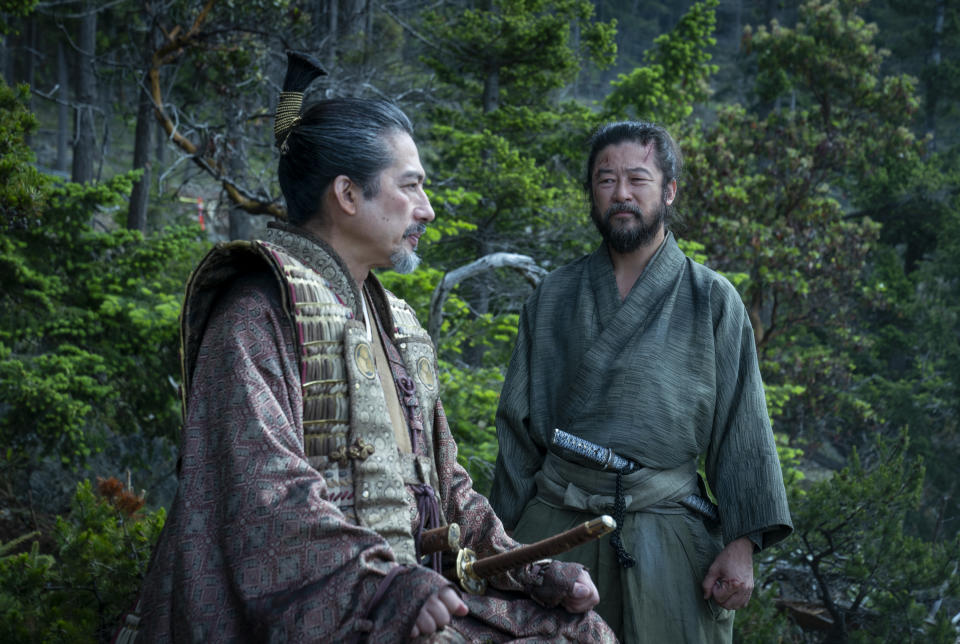
Now 50, he was 19 when he and Sanada made the first of their five films together. That personal history informed the knotty dynamic that twisted and turned between their Shōgun characters leading up to the finale in which, on a cliff overlooking the ocean as Yabushige faces punishment for his betrayals and the tragedies they have wrought, the men reveal their hidden truths only to each other.
“If Toranaga wasn’t Hiro Sanada, Yabushige would not have turned out the way he is,” says Asano. “Even Yabushige’s sweet reliance on Toranaga, in some ways, would not have shown up onscreen.”
The devious lord of Izu is an almost modern figure of anxiety, so worried about his own survival in a world teeming with danger that he agonizes to understand the moment in which a person stares down certain death. And Asano, of course, has a thoroughly contemporary analogue to explain the quirk.
“We live in a world of smartphones and social media, and you can really kill time with it,” he says. “In the environment that Yabushige is in, there’s none of that, yet he has this constant curiosity. Toranaga and others have power and control, and they create a world where you don’t have time to be curious. You have to do what your lord tells you. But Yabushige’s like, whatever. I think in a way, death was the ultimate curiosity for Yabushige. It’s the ultimate time-killer.”
And if he existed today, he grins, “he’d be an influencer”.
Another Japanese film veteran with whom Sanada had a previous working relationship was Tokuma Nishioka, cast in the key role of Toranaga’s trusted general, Toda Hiromatsu. It was while filming their most crucial scene that Sanada shed the tears his character would never be allowed to reveal.
In Episode 8, “The Abyss of Life”, as Hiromatsu sacrifices himself to keep Toranaga’s pretense of surrender intact and his generals in line, the truth of the moment is conveyed only in a wordless exchange between the two old friends. “We had to show the audience how long we’ve known each other, and how much we believe in each other, without dialogue,” says Sanada. The death, late in the season, had fans gasping.
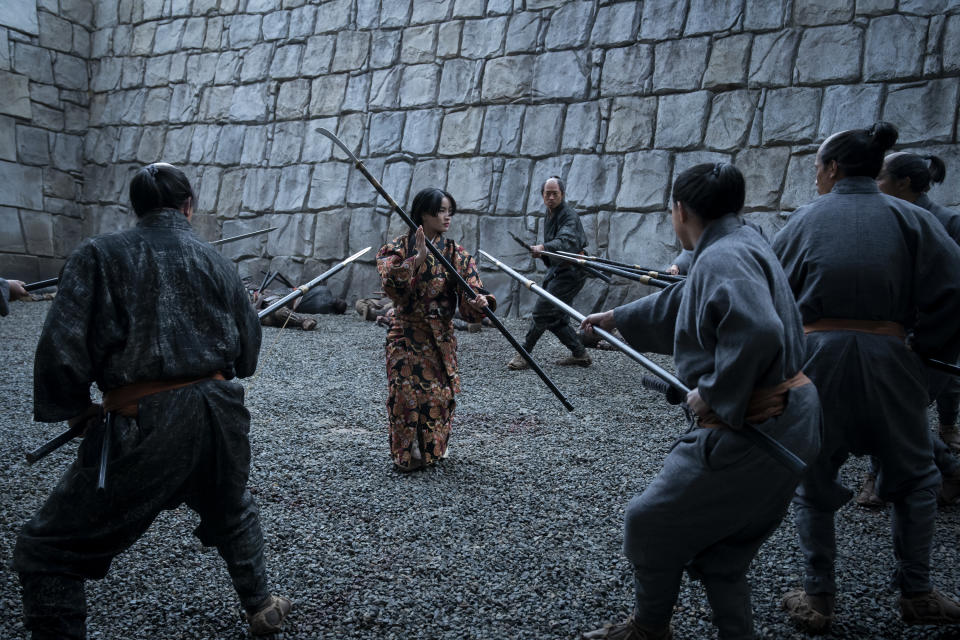
The actors worked closely with Marks to revise the scene, which originally had several protesting generals performing seppuku, for a more intimate emotional impact. “I remember that day clearly,” says Sanada. “Toranaga is almost crying inside. He knows he’s sacrificing to make a better world. Off-camera when they shot Hiromatsu’s side, I cried a lot. When the camera came to my close-up, luckily, my tears were already dried.”
But his favorite scenes on set, Sanada shares, were for an episode he didn’t appear in at all. “I had no scenes as an actor in Episode 9,” he says. “It’s Mariko’s show time.”
Marks and Kondo’s search for Anna Sawai, whose Mariko becomes the sword-fighting, beating heart of Shōgun, was the hunt for a “unicorn” who could do it all while acting in Japanese and English (the latter standing in for the Portuguese spoken with Blackthorne and Father Alvito, played by Tommy Bastow). “We didn’t have a show until we cast her,” Marks elaborates. “And until that point, I didn’t know if this was going to get to the starting line.”
At 31, Sawai’s recent credits include Apple’s historical drama Pachinko, adapted from the novel by Min Jin Lee, and a lead role in Monarch: King of the Monsters, in which she plays one of two siblings crossing the kaiju-infested globe in search of their missing father (played by Ishido himself, Takehiro Hira).
Born in New Zealand to Japanese parents who moved around Asia before settling in Yokohama, she joined a J-pop girl group in her 20s. After seeing the Japanese music industry machine from the inside, she opted out to chase her acting dreams.
Small roles in the Netflix series Giri/Haji and the 2021 action blockbuster F9 followed. Then Sawai reconsidered the types of roles she really wanted to be playing.
“The shift started with conversations like, ‘What do you want to do?’” says Sawai before a trip home to Tokyo. “It was a very slow process of allowing myself to forget everything that I had been told and to really search for what spoke to me, [which] had nothing to do with my race, doing action, or playing roles that felt submissive or just very attractive. That’s how we found Pachinko. And then that led to Shōgun.”
She was admittedly hesitant to join a Western samurai series, having seen, well, other Hollywood samurai movies that short-changed their Japanese characters. When she met with Marks and Kondo and posed the big question to the duo — “Why Shōgun?” — their answers and approach to authenticity gave her confidence that Mariko, trapped in a loveless marriage and torn between duty and desire, wasn’t going to be sexualized or exploited, but rather given agency and a full inner life.
Sawai “had some specifically acultural qualities that we found really unique and unexpected,” says Marks. “She’s able to stand outside of all of the cultures that she’s depicting, whether it be the Christian culture or the Japanese culture, and perform from a place of being lost; an island in the middle of it.” To prepare for the role, Sawai did extensive reading on Hosokawa Gracia, the real Japanese noblewoman who inspired Clavell’s character. She was moved to see a prominent line in the series taken from Hosokawa’s famous death poem.
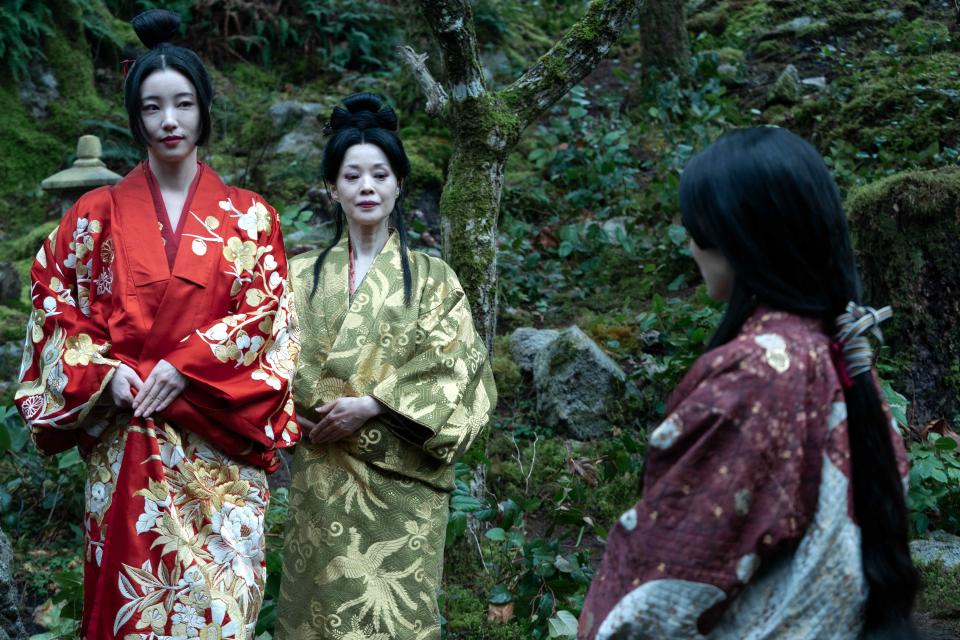
“‘Flowers are only flowers because they fall,’” she shares. “The words are different, but the message is the same: we know that it’s not forever, and that is what makes flowers, flowers, and that is what makes people, people.”
Her career-making turn as the series’ quietly incendiary heroine earned instant acclaim. As television roles go, it’s one of the trickiest in recent memory. Not only does Mariko speak two languages, often interchangeably, as she translates for the Anjin, but she also fights and trains in martial arts, rides horseback, carries herself with the physicality and gestures of feudal Japanese women, and must convey her secret feelings only to the camera, while keeping a protective veil to guard her emotions from the people around her.
“Oh my gosh, it was so hard!” Sawai says. “As an actor you’re supposed to express, but the character, culturally, has to repress. I didn’t know how to balance those two out because they’re so opposite. All I can remember is that I was boiling inside shooting those scenes, I felt so stuck. In hindsight, I can say I was feeling stuck because the character was; I was just living in her and feeling the same emotions.”
For what it’s worth, Sanada agrees with Marks and Kondo: “Anna was the only one on earth who could play this role.”
She and Jarvis were cast separately, the British actor catching Marks’ eye after watching him play an ex-boxer in the 2019 British drama Calm with Horses. “At that point in the process we had a hero who is classically trained and everything that you want, and Anna who had this hint of modernity to her and a displaced quality, and then we had this guy who seemed like he stumbled in from 1600 and was going to act for us,” says Marks. “It felt like the right energy to combine into something unexpected.”
Meeting Asano’s improvisational touches with his own, Jarvis also brought unexpected humor to the Anjin, who develops a mutual recognition with the opportunistic Yabushige.
“Cosmo has great instincts,” says Asano. “Obviously he doesn’t know Japanese, but I was able to really trust that whatever I threw at him, he would meet with a great impulse and throw the ball back at me. And in that way, with Yabushige and Blackthorne, Blackthorne ends up spinning down Yabushige’s little hurricane and getting wrapped up in it.”
While the sizzle that blooms between Blackthorne and Mariko is a slow burn rollercoaster ride frequently hampered by their philosophical differences over faith, duty, and sacrifice, the longing comes to a head when she accompanies him to visit the courtesan Kiku (Yuka Kouri) in the Willow World of Episode 6, directed by Kamata and written by Maegan Houang.
In one of the show’s most memorable sequences — which is saying something, given the tectonic mudslide that levels an entire small town and all the ritual belly slashing — Kiku, hired to entertain Blackthorne while Mariko is present, clocks the vibes between the two star-crossed lovers. She sits beyond Blackthorne’s view as Mariko translates her words, allowing Mariko to speak her own desire and longing to him in a stunningly intimate exchange.
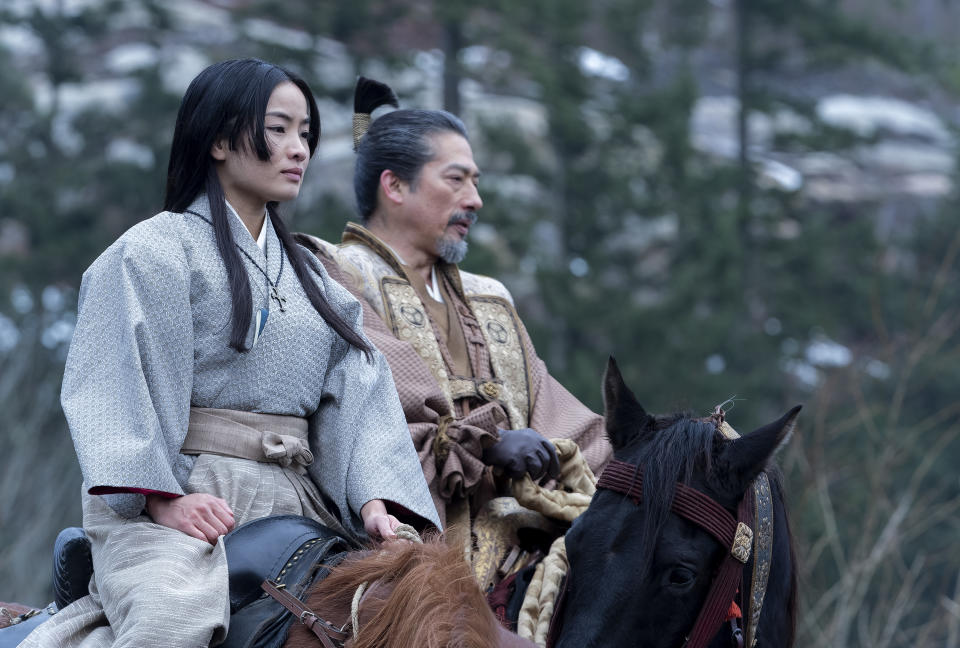
Kondo, tickled that so many viewers responded to the sequence, describes it as “the sexiest scene in which sex never happens”. (Or, as Marks calls it: “The total eclipse of the Mariko.”)
In one deft camera move lit in lush, sumptuous candlelight, as the score by Atticus & Leopold Ross and Nick Chuba spills over with emotion, the show’s creators trust their audience to meet the moment and pick up on what goes unspoken, even when the lovers part after physically sharing only a barely-there caress of the hand. (Wong Kar-Wai’s In the Mood for Love and James Ivory’s Remains of the Day, unsurprisingly, were two favorite references in the writers’ room.)
“Maegan Houang, who wrote that scene, had this great pitch in the room that lasted to the execution, which is that it feels like phone sex,” says Kondo. “That’s what Kiku is able to give them in that moment.” A few episodes later, it’s another small gesture that speaks volumes as Blackthorne volunteers to second Mariko’s seppuku, ready to behead the woman he loves in order to spare her soul.
By the time Episode 9 arrives, revealing Toranaga’s Crimson Sky to be a one-woman mission, it’s a showstopping tour de force for Mariko. Directed by Frederick E.O. Toye and written by Kondo and Caillin Puente, the episode was so intense for Sawai to shoot, she chipped a tooth while filming her naginata fight with the Osaka palace guards, just from gritting her teeth.
Kondo praises the discipline, stamina and physical capability Sawai needed to carry herself through the filming of Mariko’s grand farewell episode. “She’s a performer of the highest capability,” says Kondo. “Her level of focus is off the charts. You talk to her when we were filming Episode 9 and she’s not really there. She’s listening to you, but she’s so in her own head because it took them three, four days just to film her trying to walk out the gate. This is somebody who was performing on a level that not many can.”
One day, Sawai says, she’d like to follow in Sanada’s footsteps and produce her own passion projects, not just star in them. Asano is also eager to see what new doors Shōgun’s success opens. Both praise their producer/co-star for paving the way. “Without him and without the other Asian actors who have been in this industry for a long time, we would not have the ground to build on,” Sawai says.
Two weeks have now passed since Shōgun’s contemplative finale (directed by Toye from a script by Hoang and Emily Yoshida), brought closure to Toranaga’s grand plan, turning a hopeful eye to the future and setting up the postscript victory at the Battle of Sekigahara that will usher in his dynastic shogunate.
Reflecting on a season that had critics praising its storytelling to a near-unanimous 99% Rotten Tomatoes benchmark, and fans making internet memes out of everything from Fuji’s epic reactions to Blackthorne’s persistent calls for “my men and my ship”, Marks tries to remember the moment he really exhaled.
“I’ll let you know when I do,” he jokes.
The glowing first reviews were a promising start, “but I’ve seen it go both ways,” he says. “The writer of Street Fighter: The Legend of Chun-Li has seen all sides of these things. You have more control, fortunately, in TV today than in a genre movie, but I’m just happy that anybody liked it.”
For Kondo, that revelation happened on a random Tuesday afternoon.
“I walked into our little tiny post office here in our little town and the postal worker I always see, who’s very brusque and to the point, saw my name on the return label. He looked up and said, ‘Shōgun’. He proceeded to say more words to me than he had ever said. And I could see how deeply he was enjoying it and how closely he was watching it. It made me realize that we had asked a lot of audiences to set their phones down, to really come on this journey with us, to please give us your time and trust us. And to see the fruits of that in his response made me feel like if it could do that, and it could travel all this way to this one little island, then we did something.”
The co-creators and producers meanwhile, have been fielding curiosity from fans hungry for details of FX and Hulu’s mid-May announcement that Shōgun has been renewed for two more seasons — news hinted at when Sanada inked a deal to return as Toranaga. (Debate has raged over whether or not the former limited series should continue into additional seasons.)
It’s unclear if any Shōgun continuation might draw on the other novels in Clavell’s six-volume ‘Asian Saga’, but Sanada suggests that, with the events of the original book now exhausted, they have plenty of real history to borrow from. “We know what happened, so who knows? Only the god of shows knows,” he teases.
Marks, still catching his breath from the first season, candidly admits the right idea would need to come along. “It’s so hard to do what James Clavell did. We drafted [behind him], like when you drive behind a big truck. To have to build it from the ground up, I’m not saying it’s impossible, but it would take a great idea. And I’m not sure where that idea is — yet.”
Or maybe he already has the next epic season mapped out, hidden behind his own Eightfold Fence, teases Kondo: “He still has to keep everything in his secret heart.”
Journey Through The Cosmo – How Cosmo Jarvis Landed Blackthorne
Finding the right actor to play Pilot-Major John Blackthorne, the English sailor who washes up in feudal Japan only to become embroiled in the political games of Lord Toranaga (Hiroyuki Sanada) and his rival samurai warlords in Shōgun, was a tricky task for series co-creators Justin Marks and Rachel Kondo.
Lending a subversive spin to James Clavell’s 1975 bestselling novel, previously adapted into an Emmy-winning 1980 miniseries starring Richard Chamberlain in the role, they needed a performer who could unlock surprising dimensions in the character that some might assume was a typical Hollywood white savior.
But as Cosmo Jarvis’s Blackthorne proves over the season’s 10 episodes, there’s plenty that the restless so-called Anjin (pilot) has to learn from the Japanese, whose customs, values and bushidō (the Samurai code) he eventually comes to understand and appreciate.
Instead of imposing his Eurocentric views into the affairs of Toranaga, his interpreter Lady Toda Mariko, and others, “he takes a bunch of side doors out,” says Marks, the series showrunner, “and often through the genius of Cosmo Jarvis and through his comedy, albeit a very dry and straight-faced one.”

Hailed for his breakout turn in 2016’s Lady Macbeth, Jarvis’s credits include Netflix’s Jane Austen adaptation Persuasion, the upcoming Alto Knights opposite Robert De Niro, and Alex Garland’s Warfare. It was Jonathan van Tulleken, who directed the series’ first two episodes, who recommended Marks check out the up-and-coming British actor’s work as an ex-boxer in the drama Calm with Horses.
Marks was impressed by Jarvis’s “muscular” performance but wasn’t sure he’d be right for Blackthorne until the actor sent in a self-tape of a scene in which Blackthorne, a prisoner of Toranaga, draws a map of the known world — and Japan’s place in it — in the sand.
“Cosmo taped it in his belfry in London in the shadows, holding his iPhone,” remembers Marks, before Kondo corrects him. “It was a flip phone,” she says with a smile, “because that’s Cosmo.”
The scene felt lived-in and “made a boring scene actually exciting,” says Marks. Still, he worried that getting network sign offs on Jarvis might be a challenge, thanks to preconceived notions of what the character should be like. “That was a Friday. And on a Sunday, I woke up with Rachel, still thinking about Cosmo.”
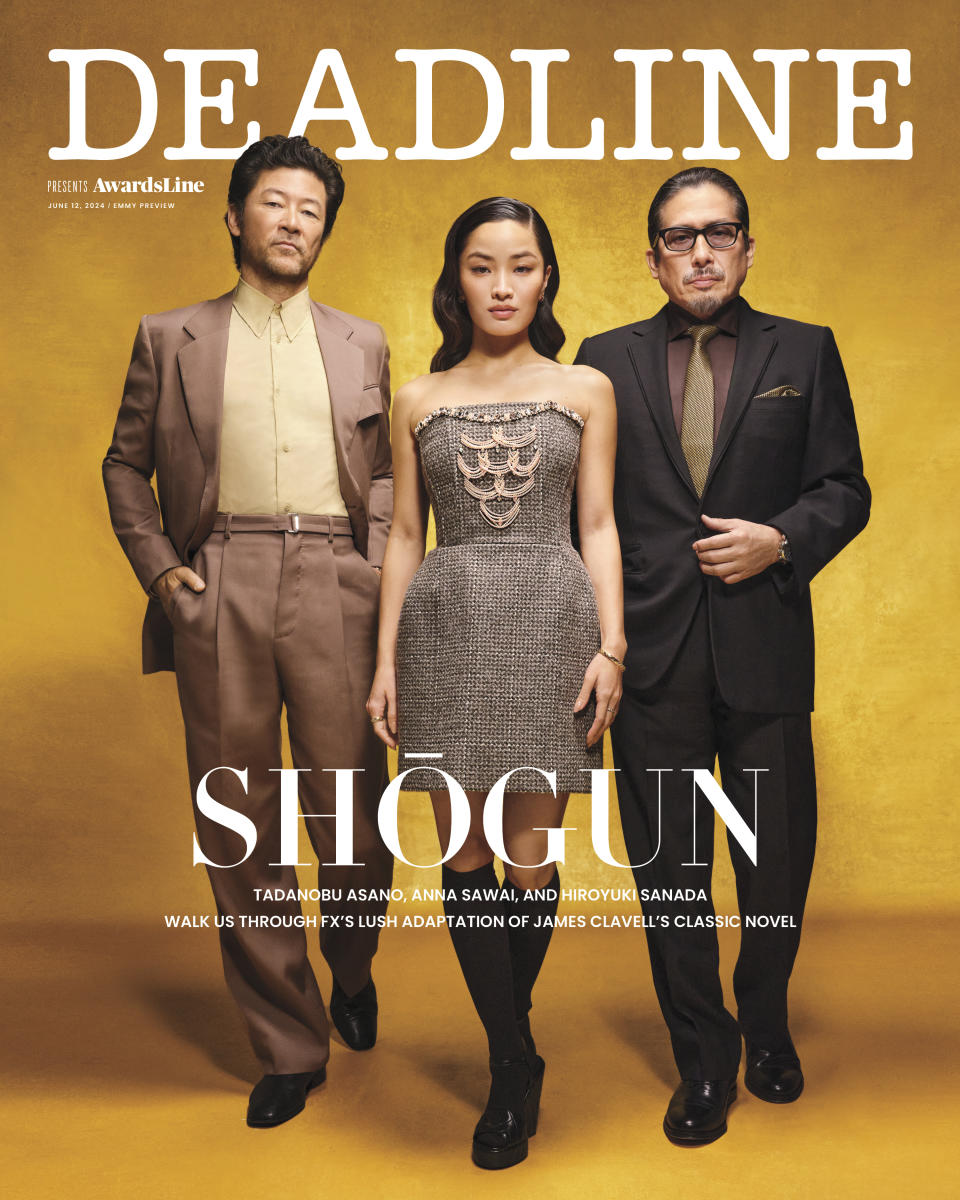
“There’s something about this guy that is so unexpected you can’t take your eyes off of him and what he’s doing,” he says. On impulse, he sent the tape to one of the show’s executives. “Within three hours the entire company had seen that audition on a Sunday afternoon, all the way up to Landgraf. And that began the conversation.”
Cast opposite Sanada as Lord Toranaga and Anna Sawai as Lady Mariko, Jarvis brought a fearlessness to the role and a helpful spirit to the production. (It remains to be seen if his journey will continue in future seasons.)
“There’s a self-consciousness that he just doesn’t possess that many good-looking dudes in that age range, who act for a living, do possess,” says Marks. “He just doesn’t have it. He’s just there. He’s trying to carry cables for everyone. You’re like, ‘Please put that down, Cosmo.’ He’s out there for the good of the show and for the good of the character — he really understood it.”
Best of Deadline
'House of the Dragon' Season 2 Release Schedule: When Do New Episodes Air?
'The Boys' Season 4 Release Schedule: When Do New Episodes Air?
Sign up for Deadline's Newsletter. For the latest news, follow us on Facebook, Twitter, and Instagram.


